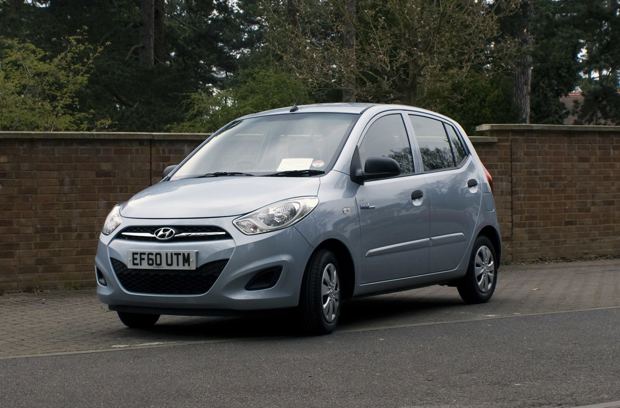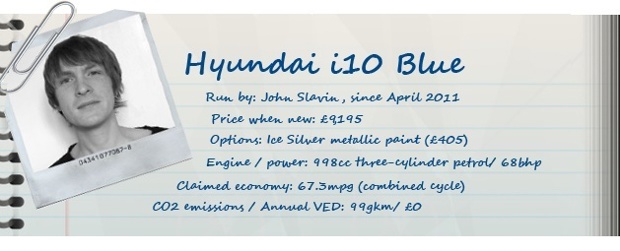It's a long way down...
The Hyundai i10 is the newest and smallest addition to the HonestJohn.co.uk fleet. It should be right at home in central London, where it’ll be living for the next six months.
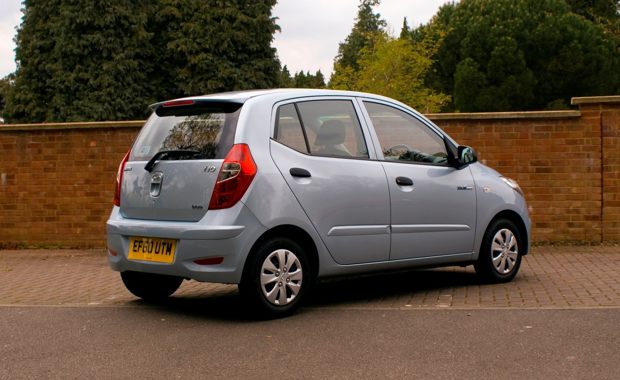
Date: 15 April 2011
In another bout of ‘it’s close enough in the spectrum’ style naming, Hyundai have decided to call their green model ‘Blue,’ much like Volkswagen and Mercedes-Benz have with their eco ranges. Say hello to the third model to join ‘Our Cars,’ the Hyundai i10 Blue.
This little city car qualifies for London congestion charge exemption after a registration fee of £10, as well as free VED, thanks to CO2 emissions of 99g/km.
The 998cc three cylinder petrol engine isn’t exactly powerful, producing 68bhp at 6,200rpm. Torque is similarly unimpressive, peaking with 70lb/ft at 3,000rpm, so it’s safe to say this car is best suited to short jaunts across town, which shows when you look at the quite impressive urban fuel economy figure of 56.5mpg. Official combined cycle economy is claimed to be 67.3mpg.
I’m not particularly kind, though, so rather than introduce you to the i10 Blue by taking it on a few short trips to the shops I decided to use it as a removal van and drive it 200 miles down the M1. The route took it from my old home in County Durham to my new one in West London. Sometimes it’s best to give things a baptism of fire...
View My i10 in a larger map
I must admit that I expected the i10 not only to struggle at this first test, but to fail entirely. I believed firmly that I would have to leave most of my clothes behind, and that it would take me several days to arrive in the Old Smoke. I was quite wrong though.
Thanks to easy to operate split/fold rear seats, increasing space in the boot is quite easy, and while it’s hardly capacious, it was big enough for my (admittedly relatively small) payload of clothing and other assorted gear.
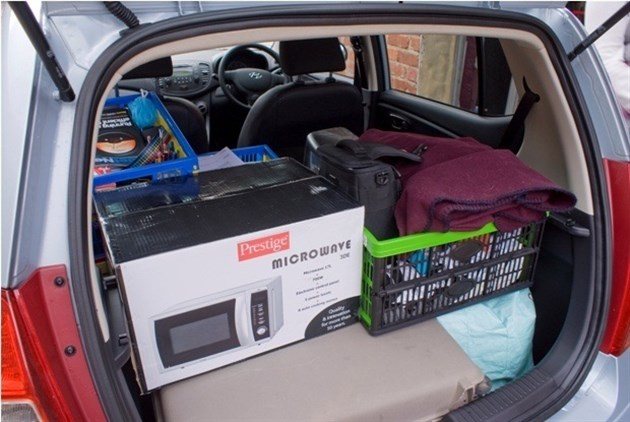
On the motorway everything was acceptable, albeit unexceptional. Noise was apparent but not overbearing, and while the little engine is certainly at its best in low gears, it just about managed overtakes with a down change and some forward planning.
I didn't bother to fill up the 35-litre tank before departing on the trip, and based on a mixture of driving before and after the long motorway cruise and the big trip itself the i10 managed a not unreasonable economy figure of 51mpg. It could have been better, but with a decent sized payload in the back and a lot of heavy-footed throttle application it's a more than acceptable figure.
Most impressive of all, though, was the comfort. I stopped for a very short break once during the whole four-and-a-half-hour trip, and despite that I arrived feeling nothing more than a little numb-legged. I’ve made the same trip in much larger cars and found them to be less comfortable, despite being designed for long journeys.
Now the little i10 it’s at its new home in the capital, it’ll be interesting to test it in the environment it was designed for, particularly when it performed so well on the motorway where, by rights, it should have been out of its depth.
What’s good?
The seats: They are very comfortable and so is the ride.
What’s bad?
The colour: I'm not sure I like the blue paintwork yet and the wheel trims don't appear to be of the best quality.
London Love
After its difficult first journey down the M1, the i10 is right at home in London town.
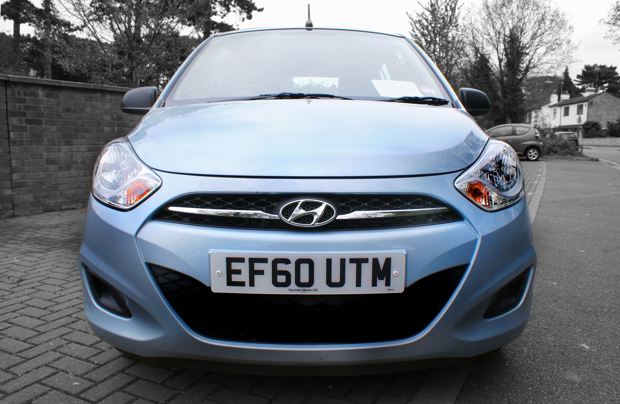
Date: 29 April 2011
It was all very well introducing the i10 Blue by driving it down the motorway, but after all is said and done, this is a city car. So the best place to spend time with it is in an urban environment. Thankfully London is very urban indeed, and it’s where the i10 and I have spent the past fortnight.
The little Hyundai has obviously been designed for the city. Firstly, it’s quite a narrow car, with a width of 1595mm. It’s not exceptionally slim for its class; the Chevrolet Spark is an almost identical 1597mm wide, and the Fiat Panda is 1578mm wide.
But when you compare it to the likes of other ‘small’ cars like the Ford Fiesta, which is 1787mm wide, you start to realise that in the tight, hectic traffic of London, every millimetre counts.
Squeezing past vans trying to turn right across an endless line of traffic is much easier in a car like the i10 than it is in larger machines, and it’s something which I’m very happy to be able to do.
View this map in a larger map
Obviously the i10 is small lengthways too. At 3565mm it’s similar in length to the three-door Fiat 500 (3546mm), but the i10 somehow manages to have five doors and a not an unreasonable level of rear legroom.
Parking is extremely easy, aided by the very light steering and a small turning circle, again perfectly suited to the annoyingly anti-car city of London, where finding a space that is big enough and that isn’t extortionately expensive is a real challenge.
There are other features that help out in town too, most notably the start/stop system which is unique to the Blue variant of the i10. Putting the car in neutral and lifting the clutch causes the engine to stop. It starts again as soon as you depress the clutch pedal.
In order for the system to function the car needs to be up to temperature, which initially concerned me since my commute is only a few miles. I was pleasantly surprised to find that the system takes about two minutes to warm up, though, and so by the second set of lights on my trip it’s ready to go.
Using the air conditioning or putting the heater on full blast prevents the system from working too, but at this time of year it’s fine not to bother with either. In practice the stop/start system, called Intelligent Stop and Go (or ISG) is unobtrusive and very quickly becomes second nature. After a few miles of getting used to the idea, slipping into neutral rather than staying on the clutch turns into a habit.
It makes sense, too. Why waste fuel when stationary? I imagine it won’t be long until similar systems are fitted to all cars and rightly so. Unfortunately, the sonorous, thrummy little engine is at odds with my fuel economy. It makes an addictive, almost funny noise when pushed hard, so that’s exactly what I’ve been doing.
Nipping up to 30mph away from roundabouts and away from the lights isn’t necessary but it’s entertaining. Over the past fortnight my fuel economy has lingered around 41mpg, and almost all of that has been in stop start London traffic. It’s acceptable, but without my hooliganism it’d be even better.
What’s good?
- Stop/start system means fuel isn't wasted when stationary. Which is most of the time.
- Easy to park and squeeze through gaps
- Aux-in means I can listen to my own music
What’s bad?
- The cabin smells odd. Like plastic.
- While my mpg is decent, it's not quite as good as official figures.
Go figure
Before the i10 I had an old 'banger' and tried to keep costs to a minimum. But after comparing the running costs of the Hyundai i10 to my old Nissan I was astounded how much more the 10-year-old Primera was costing.
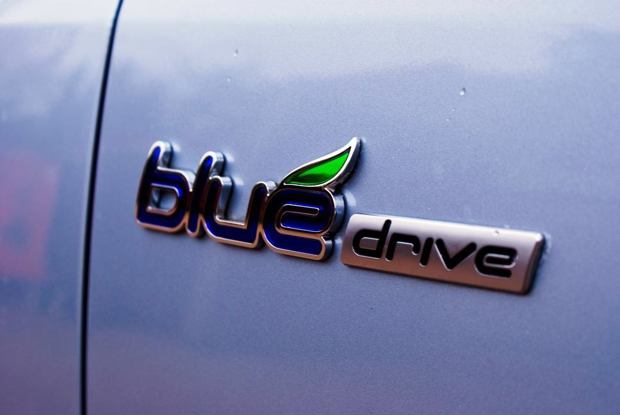
Date: 13 May 2011
Before the little i10 Blue was delivered I was getting around in a 2000 X-Reg Nissan Primera 2.0-litre Sport+. It was a large, pink car with a 140bhp four-cylinder engine that simply would not break.
I originally bought it to go up and down the motorway as at the time I lived in the north and most of the work appointments I had were in the south. I needed something sturdy and comfortable - the big Nissan fitted the bill.
I bought it for banger money - £1000 with tax and an MOT. After spending some more on replacement brakes there was little in the way of costs. Or so it seemed. But after doing some research it’s amazing just how much more the Nissan cost compared to the i10.
First up the Primera was insurance group 13, largely thanks to the Sport+ badge giving it connotations of race track fun. I held a third party, fire and theft policy and when I cancelled it, enquired about the difference in cost of insuring the Primera and the i10.
Despite the fact that the i10 is brand new and is worth nine times than the Primera, Admiral would improve my cover to fully comprehensive and yet still give me back £150. I was astounded.
The savings don’t stop there. With the old Nissan I was averaging about 34mpg with very careful driving. In town, or with a bit of heavy right foot, I was achieving a rather paltry 28mpg. In the i10 I don’t have to try and I manage almost twice that. Granted the Nissan was much faster and more fun to drive, but you can’t have everything.
Next, the VED bill for my Nissan was £245 per year thanks to band J and 206g/km of CO2. That’s £245 more than the i10s annual VED bill of zero. And now that I live in London I have the congestion zone to contend with. The Primera would cost a £9 for every day that I took it into the Congestion Zone, whereas the i10 Blue is exempt after a registration fee of £10.
All of these savings add up substantially... If I travelled 10,000 miles per year in the Primera my fuel bill would be £1850 based on London prices. The same mileage in the i10 Blue would cost £1300 with my current economy of 48mpg, and at the official claimed 67.3mpg it would cost just £930.
If you factor in VED, congestion charging on every working day of the year, extra insurance costs and fuel bills, the cost of running the i10 Blue for year comes to £3185 less than cost of running my old Primera, excluding any servicing and maintenance bills. Granted about £2,000 of that difference is down to the Congestion Charge.
But it goes to show how useful a car like the i10 Blue can be in the capital. With expensive tax, the congestion zone and rising fuel costs, buying an old banger on the cheap can be a false economy. If you’re interested in how the i10 is performing on a day-to-day basis, or if you want to ask any specific questions about it, you can follow its Twitter feed at @i10_Blue.
What's good?
The new look: The facelifted i10 looks much, much better than the older model. The updated styling gives the car a lot more character than it used to have.
What's bad?
The image: It might look a lot cuter than it used to, but it still fails to stir the soul in the way some of its rivals might. The Renault Twingo, Ford Ka and Fiat 500 are all prettier.
View My i10 3 in a larger map
The award winning i10 Blue
It might come as no surprise that the i10 Blue won the title of ‘Most Genuinely Economical Petrol Engined Car Award’ at our inaugural Honest John Awards on May 19th. Here's why...
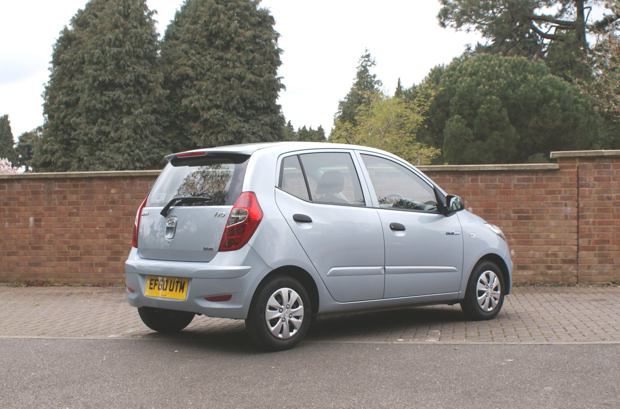
Date: 27 May 2011
My little Hyundai i10 never seems to do particularly badly on fuel. I’m never massively kind to it: I rarely ‘hypermile’ and I sometimes give it more revs than I really need too. Despite that it’s never dipped much below 50mpg, even in the most horrific of London traffic.
Many others seem to manage even greater economy figures, so it might come as no surprise that the i10 Blue won an outstanding achievement award for Hyundai at our inaugural Honest John Awards on May 19. The ‘Most Genuinely Economical Petrol Engined Car Award,’ to give it the full title.
This got me thinking – all of the other road testers and magazines try to prove the potential economy of cars by driving carefully, smoothly and with huge amounts of concentration. But surely the most economical of vehicles should manage decent figures even if you drive like an absolute fool?
So, within the bounds of sensibility and the law, I elected to do just that and see what could be achieved. Interestingly, the i10 Blue did rather well. I spent a good week driving the car without paying the blindest bit of attention to the shift indicator - accelerating as rapidly as I could to the speed limit.
I also avoided allowing the Intelligent Stop and Go system to kick in when stationary and cruised at a higher speed than was necessary. Mixed with a bit of late braking it was the perfect recipe for bad fuel economy, but all the same I managed a half-decent 43mpg. I admit there was a lot of motorway driving mixed in with the mad-dashes, though if it was all in town it might have been worse. But it's an impressive figure all the same.
This sort of test seems to provide a clearer picture of the actual real-world fuel economy than spending a week driving as slowly and as carefully as possible. It’s not all good news, though. I’ve been seeking out irritations, and there are a few.
For starters there is no average fuel consumption read out in the dash. Having a very economical car is all well and good, but if you can’t show off your impressive figures to passengers there’s something wrong. Additionally, many people can’t be bothered to use a calculator every time they fill up to check their figures.
The biggest bugbear is the price, though. The i10 Blue starts at £9195, which is exactly £1000 more than the 1.2-litre i10 Classic. Besides the Stop/Start system, the Classic trim level has the same standard equipment as the Blue, but it has the benefit of a 1.2-litre four-cylinder engine, giving improved performance.
Fair enough the i10 Blue is slightly better on fuel - the 1.0-litre three-cylinder engine in the Blue has an official economy figure of 67.3mpg compared to 61.4mpg with the 1.2-litre Classic – and it has free VED. But the real world difference in fuel economy is negligible. It’d take a long time to pay off the difference in price with free tax discs and slightly cheaper insurance costs.
Outside of London, the i10 Blue doesn’t make much sense. For just £200 more you can have a top-spec Style model with alloy wheels, remote central locking and rear-electric windows. That’s a far more sensible choice. However if you go into the Congestion Zone regularly, the Blue makes a lot more sense, offering adequate equipment, fun handling, compact dimensions and good value for money once you’ve paid off the £1,000 premium with a few months of free congestion charging.
So it’s a geographical decision, really... but I live in London, and I really like this award winning little car.
The good:
It’s really, really good on fuel.
The bad:
It’s more expensive than it should be.
Meet the rivals
Small cars like the i10 occupy a busy marketplace, with seemingly every car maker building something little, frugal and cheap. So if you’re interested in the i10, here’s how it stacks up against models from rival makers.
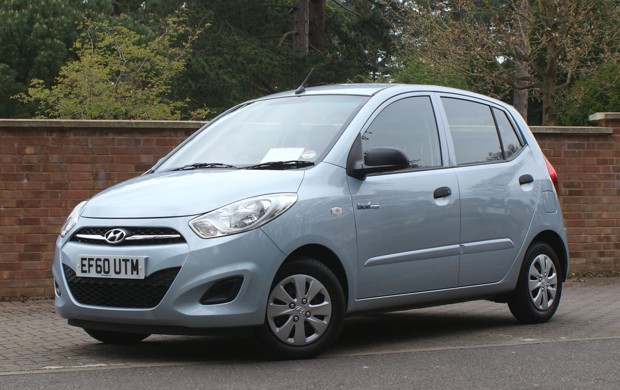
Date: 10 June 2011 | Mileage: 4500 | Average economy: 50mpg
Small cars like the i10 occupy a busy market, with seemingly every carmaker building something little, frugal and cheap. That means there’re plenty of options and lots of competition. So if you’re interested in the i10, here’s how it stacks up against models from rival makers.
First, the Fiat Panda. Priced from £8155, the Panda is almost the same price as the i10, which starts at £8195. However unlike the i10, the basic Panda doesn’t come with air conditioning or iPod connectivity as standard. There’s also no sub-99g/km choice for London drivers.
The i10 has a five-year warranty, compared to the Panda’s three year package. If you really, really want a diesel though, the Panda is available with a 1.3-litre Multijet diesel engine but there are no diesel-engined i10s.
Fiat also make the 500, a three-door car that lacks the practicality of the i10 and costs more – the most basic model starts at £9665. While on paper the i10 is better, to many buyers there is no substitute for flair and the 500 has it in spades. The Twin-Air model is congestion charge exempt but it costs £10,895, almost £1000 more than the i10 Blue.
Based on the same platform as the 500 is the Ford Ka. It’s certainly pretty, with styling similar to that of the bigger Fiesta but, again, as seems to be the emerging pattern, it’s more expensive than the i10. The basic 1.2-litre Style model costs £8545 and it doesn’t even have electric windows. To get them you need to get the Edge trim level which is £9545. On top of that, MP3 connectivity is a £250 option on all trim levels.
On paper, the basic 1.0-litre Chevrolet Spark looks compelling, with a very low starting price of £7215. But that doesn’t even get you a CD-player... I’m not joking! For such luxuries as electric windows, air conditioning and a CD-player you need a ‘+’ spec model, which is priced fairly close to the i10 and Panda, at £8695. The LS spec is reasonable value, but the Active trim i10 offers more standard equipment, including alloy wheels and electric mirrors.
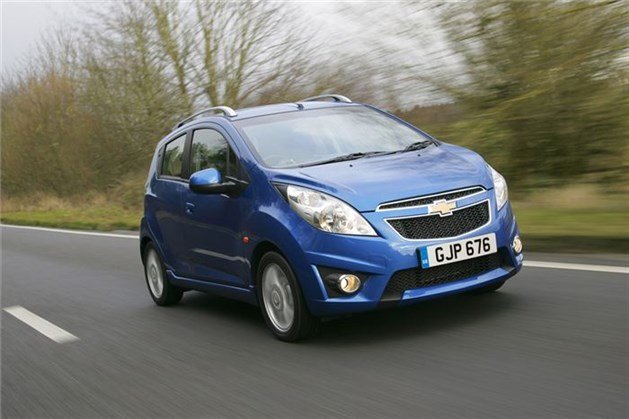
It seems the i10 offers the best small car package around, particularly in 1.2-litre Active trim, which is priced £8,795 and offers electric front and rear windows, air conditioning, and electric mirrors as standard.
However, there are a few thorns in the i10’s side, and they come in the form of the new Kia Picanto and the Suzuki Alto. The 1.0-litre Picanto in ‘1’ trim is just £7995 and it’s fitted with the same congestion charge exempt engine as the i10 Blue as well as a reasonable standard spec. However it doesn’t have air-conditioning unless you select the ‘1 Air’ spec, which costs £8595.
The Picanto also has a better warranty package of seven years, compared to the i10’s five. But even so the i10 offers a value-for-money package, particularly in 1.2-litre Active specification which gives good fuel economy, performance and equipment levels for a reasonable price.
The Suzuki Alto is a well styled, cute little car that's certainly more aesthetically attractive than the i10 and it's about the same price too, starting at £7820. For that you get electric windows, but no air-con. The interior is cute, but the quality isn't quite up to that of the i10. Even so, it's easy to make a case for it based on the looks, low purchase price and low running costs.
We think the i10 is one of the best small cars around – and despite stiff competition in the form of the new Kia Picanto and Suzuki Alto, it’s probably safe to say that it still is...
It's the little things
After a few months running the i10, some of the clever little details start to catch your attention a little more.

Date: 27 June 2011
I’ve spent three months with the Hyundai i10 now so I’ve gotten used to the major aspects of it – the drive, the performance and the economy. Driving it now is second nature so the smaller details have started to come to my attention more and more.
The other day, for example, the washer fluid ran out. When I opened the bonnet I was immediately presented with the washer fluid filler, in the most sensible and obvious place it could be – right at the front of the engine bay, with no other fillers for things like brake fluid or oil anywhere nearby.
That means access is extremely easy: there’s no scrambling around grazing knuckles on sharp bits of the engine, and no leaning over at uncomfortable angles. It’s the same story with the dipstick, which is nice and easy to pull out and very easy to read.
Sensible design continues inside the cabin. The gear lever is mounted high up, just below the radio and air-conditioning controls, which makes life much easier when you’re in town and you need to change up and down regularly.
Mounting the gear lever where it is frees the space on the floor for some cup-holders, one slightly smaller than the other. That’s handy because one is more suited to bottles, the other to cans.
There’re plenty of small cubby holes in which to keep change, parking cards and, as is inevitable, empty wrappers.
The radio is very intuitive and easy to use. All of the buttons are labelled sensibly and because the unit is so big it’s not fiddly and irritating when you’re on the move. The screen is large and easy to read so you can see exactly what you’re listening to. It’s also well lit, excellent during the day.
But knowing that a bright blue light of that size would surely distract the driver at night it’s fitted with an easy to find and obvious day/night button. Pressing this turns the radio display off, and operating any other button turns it back on.
The audio quality from the four speakers is impressive for a car in this class. There’s decent bass, only minor distortion and a good degree of user control on levels of treble, bass and midtones. It’s hardly going to impress a car audio fanatic, but for every day use it’s very good, better than systems in some more expensive cars.
There’s also a dimmer for the whole dashboard. This isn’t particularly exceptional, but it proves useful on a long drive at night. I did observe, however, that when set to its dimmest the dashboard will occasionally flicker, which gets distracting. It could be a quirk with this particular car, and it’s hardly a catastrophic problem.
Something else that’s irritating on a long trip is the armrest on the door. The plastics used for the interior are sturdy and they feel solid, but using them on the armrest isn’t conducive to comfy elbows. Perhaps a little fabric would be advisable here, but it’s a minor criticism, particularly when the seats are so supportive and comfortable.
It’s all going well for the i10 at the moment. It’s at the stage where niggles and irritations will come to attention ever more often, and so far there are only very minor criticisms.
If you’re interested in asking a question about the i10, follow its Twitter feed @i10_Blue.
Exempt-lary performance
Even when compared to used cars the i10 Blue makes financial sense for those who want congestion charge exemption
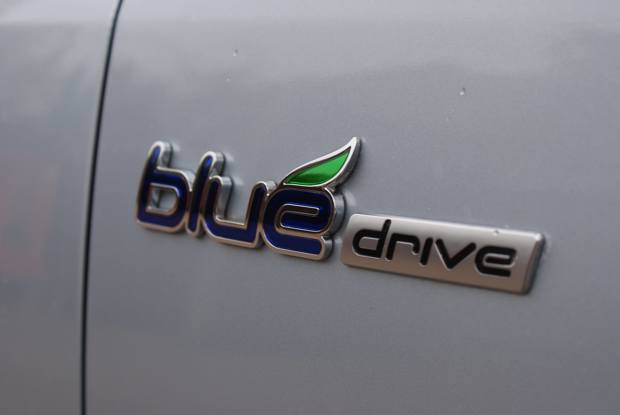
Date: 14 July 2011 | Current mileage: 6,200 | Average economy: 52mpg
Driving into the congestion zone every week day of the year would cost £2,600, so it’s understandable that buyers who drive into central London fairly often want to buy a congestion charge exempt car.
There a few ways to go about it – Euro V compliant new cars which emit below 100g/km of CO2 are exempt after a registration fee, as are plug-in hybrids, electric vehicles and vehicles with more than nine seats.
When I first got the i10 Blue I pointed out that it was the cheapest congestion charge exempt car on sale, and at the time it was. It almost still is, but the new Kia Picanto has just knocked it off its perch, the basic but still exempt model coming in at £7,995, or £8,595 when fitted with air conditioning.
But that referred to new cars – is the i10 Blue still a bargain for Londoners when they consider buying used?
With a fairly sensible budget if £10,000 you’d expect to be able to find any number of congestion charge exempt vehicles on the used car market, but... well, you can’t.
The immediate go-to point for anyone who wants to be green is the Toyota Prius, and your £10,000 will get you one with a fairly decent level of equipment, but it’ll be a mk2 model.
The mark 2 produces an impressively low 67g/km of CO2 on the combined cycle, but don’t write your cheques just yet – the latest congestion charging refresh introduced the Greener Vehicle Discount, and thanks to that in order to qualify for exemption sub 100g/km cars must also have Euro V engines.
The second generation Prius is only Euro IV compliant, and so after December 2012 it will no longer qualify for exemption.
Besides the Prius there are a few other options for under £10,000, including one-year-old Vauxhall Corsa Ecoflex and Ford Fiesta Econetic models, both of which are exempt.
They’d make suitable cars for those who commute from further afield, but with diesel engines they’re less suitable for urban driving than the petrol engined i10, which is simpler and cheaper to maintain, as well as kinder to the environment thanks to lower particulate and NOX emissions.
Finally, if you’re willing to flaunt the rules, you could buy a 12-seat Land Rover Defender. In fact, you can get one for as little as £3,000 – but don’t expect much relief in the way of fuel economy or running costs, and good luck parking it in central London!
It seems that for the Londoner looking for congestions charge relief, the two most sensible choices are the Kia Picanto and the Hyundai i10 Blue, even taking the used car market into consideration.
Picking between the two, though, comes down to personal preference. But no matter which you choose it’s likely to be a wise buy.
Accessorize!
I haven't driven the i10 far lately, but that's given me time to ponder the numerous accessories Hyundai offers for it.

Date: 29 July 2011
Since the Hyundai i10 was delivered it’s been fairly easy to establish that the range generally offers good value for money, good quality, decent fuel economy and a well thought out cabin.
But the i10 is perhaps lacking in one area, and that’s looks. It’s hardly outstanding on the eye, and for most buyers that won't be a problem.
However, covering all bases as they do, Hyundai has the needs of those who want a bit of ‘flair’ covered.
Besides the usual trim levels (Classic, Active, Blue and Style) and the standard equipment they offer, Hyundai has a selection of optional accessories to help liven the i10 up, including vinyl flower graphics, a sporty spoiler, a selection of gearknobs, chrome sill inserts, grill inserts and various other assorted bits and pieces. You can even overcome the i10’s narrow appearance with a set of wheel arch extensions...
But not all of the accessories are superficial. Tow bars, roof boxes, bike carriers and cargo rails are all available, along with child seats, a snowboard and ski carrier, a dog guard and parking sensors.
Rear parking sensors cost £135, which isn’t exactly expensive if you’re prone to bumps and scrapes, and other options are fairly well priced, too. £50 gets you a boot floor protector, handy if you make regular trips to the tip, and roof bars cost from £113.
It’s is debateable, however, whether or not it’s worth spending more than £1,000 on a flip-out infotainment system with sat nav and Bluetooth. Perhaps a little steep.
Besides my pondering of the various accessories Hyundai has on offer the i10 it hasn’t received much attention over the past week, because I’ve been driving an Audi A1.
It’s cruel to compare the two as the Audi costs substantially more. However one thing I observed was, despite the A1 being reasonably efficient – I managed about 45mpg indicated, so probably slightly less in reality – the small difference in economy between it and the i10 really does make a difference to your wallet.
Covering about the same distance in the A1 as I usually do in the i10 cost £10 more in fuel, so over a year it’d cost an extra £520.
Granted I drive further than most people do in a week but even so, when the extra costs accumulate, the savings someone can make by picking a sensible, fuel efficient car really do show through.
Just think, you could use that £500 saved on fuel to put some flowers and chrome on your i10...
Air con-undrum
It's been warm, and standard air-con has been a boon - but it saps power and fuel economy, quite noticeably so.

Date: 18 August 2011 | Average fuel economy: 59mpg
All of the trim levels in the Hyundai i10 range come with air conditioning as standard, which is fantastic. Once you’ve owned a car with air-con it’s really difficult to go back to a car without, it makes summer driving bearable, even in the most extreme heat.
It does reduce fuel consumption yes, but only by a few mpg. On my last long commute I used the air-con sporadically whenever it got particularly hot, turning it off when it wasn’t needed and still achieved just under 60mpg.
There are a couple of niggling annoyances that I’ve started to notice with the air-con system lately though – first of all there is a green indicator light in the button. It lets you know whether or not the system is active, but you can only see it at night because it’s quite dim. It’s not much use when there’s no sun and no need for air-con.
More importantly though, there is a noticeable drop in performance when the air-con compressor kicks in. On larger, more powerful cars that drop still exists; air con compressors do sap a little power from the engine, which is why fuel consumption increases when the system is turned on.
The problem comes when there isn’t much power in the first place, as is the case with the i10. In town it makes very little difference, but out on the A-roads and motorways that little drop in performance means that sometimes you have to turn the system off when accelerating to overtake or when joining the carriageway from a slip-road.
It’s a little frustrating at the very least. In and around town, the environment which the i10 was designed for, there’s no real problem at all, it’s only noticeable when you’re on a fast road. It’s not dangerous, by any stretch, but it’s best to be aware of it.
That said, keeping on top of the air con is probably a sensible thing to do anyway – turning it on when it’s needed and off when it’s not rather than leaving it on all of the time is a good way to improve your fuel economy by a few mpg.
Besides the double edged sword of an air con system the i10 has been perfectly admirable of late. The easy to fold rear seats are a joy to use and make the load space large enough for plenty of boxes and bits and pieces, and with careful driving the fuel bills are tiny.
With an auxiliary inout and USB-in as standard, listening to your own music is easy, but lately I’ve been listening to the radio more often and I’ve found that tuning to new stations and saving them to memory is about as simple as it could possibly be. Reception is generally very good, too.
Summer is almost at an end, too, and the heater doesn’t slow anyone down...
Practicality in finer detail
When you've been driving a car for a few months you start to notice finer points, like the layout of the engine bay and the folding of the seats.
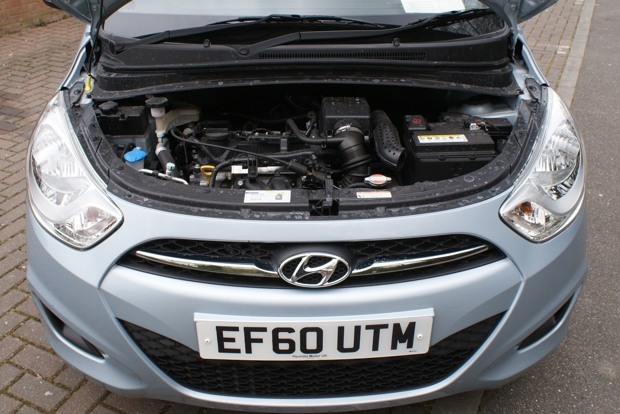
Date: 3 October 2011 | Current mileage: 9047 | Average economy: 57.3mpg
Small cars are usually blighted and blessed by their small size in equal measure. Thanks to being short and having a wheel in each corner they’re usually nimble in town and easy to park, but with the disadvantage of limited passenger space and a tiny boot.
However, the Hyundai i10 is well packaged and all models come with five doors. Because of the tall body there is a lot of space in the back. It’s possible to carry two adults without too many complaints and the seats are comfortable enough for a reasonably long journey.
The boot is less impressive though. It’d be cruel to call it inadequate – a weekly shop for two fits in with absolute ease – but it’s not going to carry a small family and their shopping while a trip away would be difficult with rear seat passengers. But while many cars at this price have a single folding bench seat, the i10 has seats that split and fold as standard. That means you can carry one or two passengers in the back and still have a reasonable amount of space for bags.
As a day-to-day vehicle it’s hard to pick faults with the i10 but when it comes to maintenance there are some niggles. Out of interest I inspected how to change the headlight bulbs. Luckily it wasn’t because a replacement was needed because changing them is a fiddly job. As the lights are so large and the front of the car is so short the only way to access the main and dipped beam bulb is to take the wheel arch liner out and reach up and under.
That’s do-able at home but it’s far more difficult than you’d expect it to be. Changing fuses would also be slightly problematic because the fuse box is low down and hard to reach. It doesn’t have a fuse-puller either, or at least I couldn’t find one. So if the fuse for the wipers blew and you were out on the road, you’d have to wait for the rain to stop so you could go home and pop the spare fuse in.
Other routine tasks are very easy though. Accessing the engine bay is simple thanks to a clearly placed release and when you get to the engine bay there’s no big ugly cover obscuring the view. That makes checking and topping up fluids an easy task. Changing the wipers is extremely easy too. The rear one pops on and off and the front two are relatively simple to slide on and off their arms.
When buying a car it’s easy to overlook the likes of maintenance tasks because they don’t cross your mind early on, but it’s always worth a quick look under the bonnet to see what’s what.
None of the problems with the i10 would deter me, though. They're just something to be aware of, because tasks like changing a bulb or a fuse, or fitting new wiper blades, will eventually come up at some point during ownership.
Windy and wobbly
After a trip up the motorway the lightweight i10 shows a weak spot in some blustery weather.

Date: 21 October 2011 | Current mileage: 9767 | Average economy: 57.2mpg
I’ve been driving the i10 for about six months now and in that time it’s rained a few times, been cloudy a few more, and otherwise been quite sunny. It hasn’t frosted and it hasn’t been very windy – at least, until this week.
On a two hour journey to the midlands it was blowing a fairly strong wind across the motorway, which is always a bit uncomfortable, but it didn’t seem to be causing many other drivers much hassle.
The i10, on the other hand, was being buffeted and blown from side to side and needed constant steering adjustments to keep it on a straight path. It’s a lightweight car and is narrow, tall and slab-sided, and this was obviously at odds with the weather conditions.
It meant slowing down, which is of course a sensible thing to do in such conditions, but even at lower speeds it was quite a disconcerting experience. Most cars will be knocked off course by a good gust of wind, but the i10 felt quite precarious.
It’s a bit cruel to discredit it on those grounds, though, because it’s not really meant for long motorway trips and is much more at home in the sheltered streets of towns and cities. In six months of ownership it’s been windy once and all I needed to do was slow down by 10mph.
As my time with the i10 draw nearer to its end I’ve realised just how good it has been. It’s comfortable, reliable, frugal and feels light and nimble to drive, and it’s coped with any challenge I’ve thrown at it.
Farewell, i10!
After six months, 10,000 miles, 172 gallons of petrol and numerous trips across the country, it's time to say goodbye to the Hyundai i10.
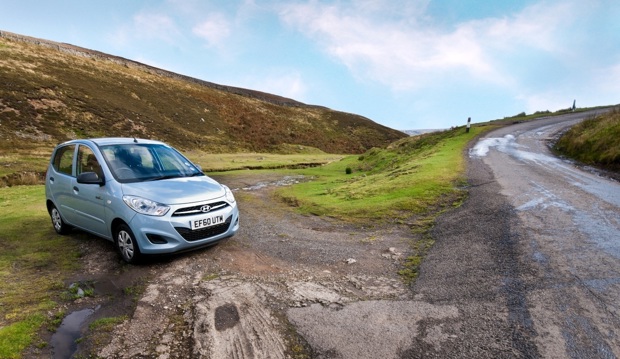
Date: 4 November 2011 | Current mileage: 10,143 | Average economy: 58.9mpg
Believe it or not, the Hyundai i10 has been with me for six months, and so it’s time to bid it farewell. The recorded mileage sits at just above 10,000, and over the past six months my average fuel economy has been an impressive 58.9mpg.
That means I’ve used 172 gallons of petrol, which has cost me about £1050. Had I been driving an eco diesel I’d have expected about the same economy, but it would have cost £50 more in fuel, not to mention the extra initial cost of buying a diesel car in the first place.
The i10 is, of course, in its element in the city, but the biggest surprise of the past six months is how well it copes on motorways and dual carriageways. For the odd weekend away it’s ideal, coping very well over long distances. Larger cars are quieter and offer better overtaking performance than the i10, but it’s certainly as comfortable on a three or four hour drive as some big saloons.
It’s not all perfect, though. It’s tall sided and lightweight, so it catches the wind and feels a little precarious in bad weather. In rain the roof sounds curiously thin, and if you forget to lower the parcel shelf it obstructs the view out of the rear. Luckily the last problem can be overcome with a gentle shove of the throttle, which makes it thud back into place.
It’s all well and good me telling you what it’s like to drive the i10, but if you’ve got a family then there’s every chance you’ll have a passenger with you for a lot of your journeys. My other half has spent almost as much time as me in the i10, but, being unable to drive, she’s seen it from a different perspective.
She says “the interior is roomy and sturdy but isn’t made of the fanciest materials.” She’s happy enough to sit in the passenger seat on long trips, though, and she also appreciates the standard AUX-in connection, which allows her to listen to her iPod.
On the other hand she thinks it needs more power to make country drives more interesting and she absolutely hates the colour, which she rather aptly calls “blue rinse metallic.”
In the Blue trim level, which I’ve been running for the past six months, the i10 is congestion charge exempt, which made sense initially. But it didn’t take long to realise that those big red Cs painted on the road to indicate that you’re entering the London congestion zone should only be regarded as a good place to do a U-turn.
Driving in central London is best avoided, even in a congestion charge exempt car. Parking charges are eye-wateringly extortionate and most journeys take less time on foot than they do in a car, thanks to scores of traffic lights and frankly ridiculous numbers of traffic jams.
Which brings me neatly on to my conclusion - in the Blue trim level, the i10 comes with less kit than the 1.2-litre Classic model, which gets alloy wheels, electric windows and a more powerful engine. Despite that, the Blue - which doesn’t even have remote central locking - costs £400 more.
So in short, if you’re in the market for a small car, then you should definitely consider the i10 – but unless you absolutely must drive into the congestion zone on a regular basis, buy the 1.2 Active and leave the Blue alone. If you do that you’ll end up with what is probably the best value car in this price bracket.
What's good:
- Excellent fuel economy
- Practicality of five doors and folding seats
- Works well on the motorway
- Makes an ideal city car
What's bad:
- The 1.2-litre i10 is almost as efficient but costs less
The bubble chart below shows all the figures you'll need to know about the i10 from the last six months.

